Trees Birds Mammals Fish Amphibians Reptiles
Wild Algarve
Bookshop
Ganoderma pfeifferi Bres. - Beeswax Bracket
Phylum: Basidiomycota - Class: Agaricomycetes - Order: Polyporales - Family: Ganodermataceae
Distribution - Taxonomic History - Etymology - Identification - Culinary Notes - Reference Sources
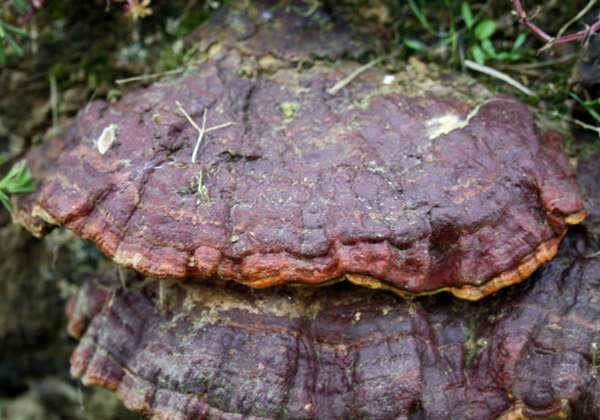
Ganoderma species are notoriously difficult to identify with confidence because of their variability, but Ganoderma pfeifferi has one very useful distinguishing feature: in late winter and spring the pore surface secretes a yellow, sweet-smelling waxy substance. (No other Ganoderma has such a waxy layer.) In addition, a thumbnail will easily indent the upper surface, which melts when a burning match is held against it.
At maturity the pores of these bracket fungi release clouds of chocolate-brown spores, which attach themselves to the upper surface of the cap (and the bark of the tree to which it is attached) thereby masking its true colour.
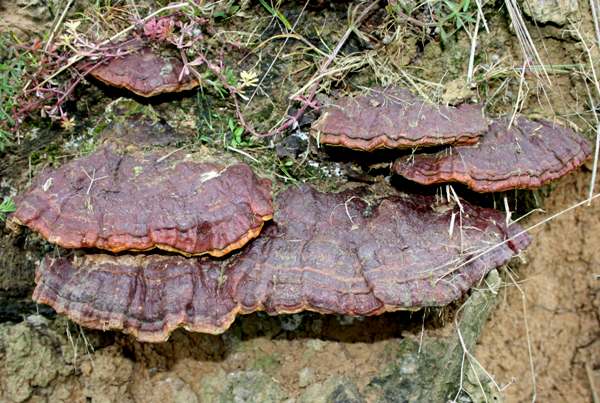
Distribution
An uncommon find in Britain and not formally recorded in Ireland, Ganoderma pfeifferi is an uncommon find in southern England and very rare in Scotland and Wales. This bracket fungus occurs in parts of mainland Europe, from the Iberian Peninsula up to southern Scandinavia. Ganoderma pfeifferi has also been reported from Indonesia.
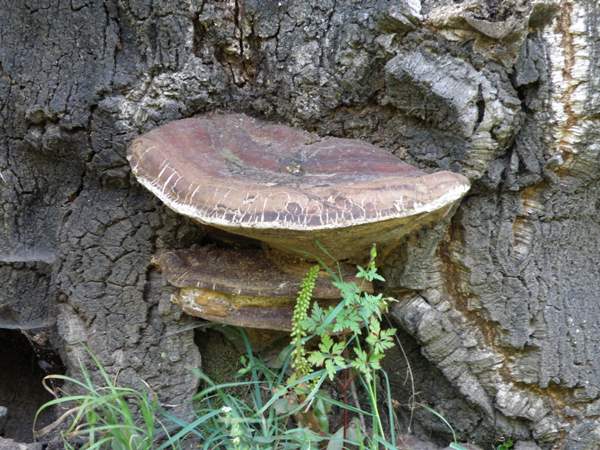
Taxonomic history
The species was described in 1889 by Italian mycologist Giacopo Bresadola (1847 - 1929), who gave it the scientific name Ganoderma pfeifferi by which this bracket fungus is still generally known today.
Synonyms of Ganoderma pfeifferi include include Ganoderma applanatum var. laccatum (Kalchbr.) Rea, Polyporus laccatus Kalchbr., and Fomes laccatus (Kalchbr.) Sacc.
Etymology
From the Greek Ganos-, meaning brightness or polished to a bright sheen, and -derma meaning skin, comes the genus name Ganoderma - a reference to the lacquered appearance of the caps of these bracket fungi.
The specific epithet pfeifferi may be in honour of Ludwig Karl Georg Pfeiffer (1805 – 1877), German physician and botanist; however, to date I have found no reference source for this attribution.
Identification guide
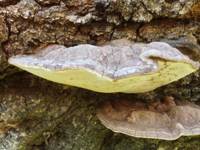 |
Fruitbody
Perennial; growing to 30cm across and 5 to 12cm thick, broadly attached nearly always low down on the trunk of a mature tree. Upper surface is copper-red or purple, crust; concentrically grooved amd lumpy, often wavy toward a pale yellow resinous growing margin; cracking and eventually blackening when very old.
|
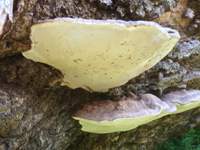 |
Fertile surface
The lower (fertile) surface is covered in roundish pale cream pores spaced 4 to 5 per mm. The pores turn darker cream and then ochre with irregular brown spots when fully mature. |
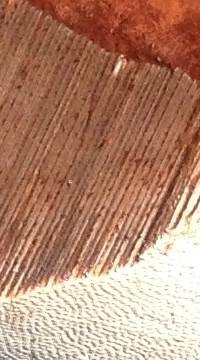 |
Tubes and Pores
The chocolate brown tube layer is up to 2cm thick. Tubes terminate in small roundish pores that are just perceptible to the naked eye; they are white when the fruitbody is young,
turning cream and eventually ochre with age or when bruised.
The flesh above the pore layer is chestnut brown. |
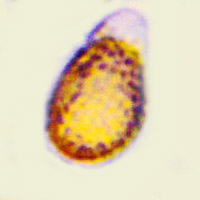 |
Spores
Ellipsoidal to ovoid with one end flattened, twin walled, 9-12 x 6-9µm; inner wall ornamented with many spiny warts.
Spore print
Chocolate brown. |
Odour/taste |
The pore surface is sweet-smelling, somewhat like honey or, so some say, like beeswax; taste not distinctive. |
Habitat & Ecological role |
Mostly on Fagus (beeches) and occasionally Quercus (oaks); very rarely on other hardwood trees, nearly always near the base of the trunk. |
Season |
This perennial bracket fungus releases spores in summer and autumn, but the tough fruitbodies persist for several years. |
Similar species |
Ganoderma resinaceum oozes a resin when cut.
Ganoderma applanatum, the Artist's Fungus, has much smaller spores |
Culinary Notes
In the Far East a wide range of medicinal claims are made for for various Ganoderma species, and extracts are made from the brackets and from their spores. Researchers in Germany have isolated a number of antiviral terpenoid constituents in Ganoderma pfeifferi, and their findings may lead to inhibitory treatments against the herpes simplex virus. We know of no recipes for soups or other mushroom dishes based on this tough bracket fungus.
Reference Sources
, Pat O'Reilly, 2016.
Patouillard, N. Le genre Ganoderma. Bull. Soc. Myc. France, vol. 5, p. 64, 1889.
Mattheck, C., and Weber, K. Manual of Wood Decays in Trees. Arboricultural Association 2003.
Dictionary of the Fungi; Paul M. Kirk, Paul F. Cannon, David W. Minter and J. A. Stalpers; CABI, 2008
Niedermeyer, T H et al; Antiviral Terpenoid Constituents of Ganoderma pfeifferi. J Nat Prod. 2005 Dec; 68(12): pp1728-31.
Taxonomic history and synonym information on these pages is drawn from many sources but in particular from the British Mycological Society's GB Checklist of Fungi.
Acknowledgements
The pictures shown on this page were kindly contributed by Simon Harding.
Top of page...
Fascinated by Fungi. Back by popular demand, Pat O'Reilly's best-selling 450-page hardback book is available now. The latest second edition was republished with a sparkling new cover design in September 2022 by Coch-y-Bonddu Books. Full details and copies are available from the publisher's online bookshop...